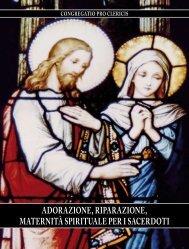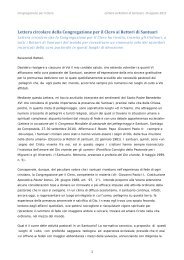Testo originale:GATEWAY LITURGICAL CONFERENCEADDRESS OF HIS EMINENCE CARDINAL FRANCIS ARINZESt Louis, Missouri (U.S.A.)Saturday, 11 November 20061. Excelling Dignity of Liturgical PrayerThe Church which was founded by our Lord and Saviour Jesus Christ strives to bring together men and women from every race,language, people and nation (cf. Rv 5: 9), so that "every tongue should acknowledge Jesus Christ as Lord to the glory of God theFather" (Phil 2: 11). On Pentecost day there were men and women "from every nation under heaven" (cf. Acts 2: 5) listening as theApostles recounted the wonderful works of God.This Church, this new People of God, this Mystical Body of Christ, prays. Her public prayer is the voice of Christ and his Bride theChurch, Head and members. The liturgy is an exercise of the priestly office of Jesus Christ. In it, full public worship is performed bythe whole Church, that is, by Christ who associates with him his members."From this it follows that every liturgical celebration, because it is an action of Christ the priest and of his Body the Church, is asacred action surpassing all others. No other action of the Church can match its claim to efficacy, nor equal its degree of it"(Sacrosanctum Concilium [SC], n. 7). From the sacred spring of the liturgy, all of us who thirst for the graces of the redemption drawliving water (cf. Jn 4: 10).Consciousness that Jesus Christ is the high priest in every liturgical act should instil in us great reverence. As St Augustine says: "Heprays for us, he prays in us, and he is prayed to by us. He prays for us as our priest; he prays in us as our head; and he is prayed toby us as our God. Let us therefore recognize our voices in him and his voices in us" (Enarratio in Psalmum, 85: CCL 39, 1176).2. Different Rites in the ChurchIn the sacred liturgy the Church celebrates the mysteries of Christ by means of signs, symbols, gestures, movements, materialelements and words. In this reflection we are focusing on words used in <strong>di</strong>vine worship in the Roman or <strong>La</strong>tin Rite.The core elements of the sacred liturgy, the seven sacraments, come from our Lord Jesus Christ himself. As the Church spread andgrew among various peoples and cultures, various ways of celebrating the mysteries of Christ also developed. Four parent rites canbe identified as the Antiochene, Alexandrine, Roman and Gallican. They gave rise to nine major rites in the Catholic Church today:in the <strong>La</strong>tin Church the Roman Rite is predominant, and then among the Eastern Churches we find the Byzantine, Armenian,Chaldean, Coptic, Ethiopian, Malabar, Maronite and Syrian Rites.Each "Rite" is an historic blen<strong>di</strong>ng of liturgy, theology, spirituality and Canon <strong>La</strong>w. The fundamental characteristics of eachundoubtedly go back to the earliest centuries, the essentials to the apostolic age if not to Our Lord himself.The Roman Rite, which is the subject of our reflection, is in modern times, as we have said, the predominant liturgical expression ofthe ecclesial culture we call the <strong>La</strong>tin Rite. You will know that in and around the Arch<strong>di</strong>ocese of Milan a "sister Rite" is in use thattakes its name from St Ambrose, the great Bishop of Milan: the "Ambrosian Rite". In certain locations and on special occasions theliturgy is celebrated in Spain accor<strong>di</strong>ng to the ancient Hispanic or Mozarabic Rite. These two venerable exceptions do not concernus here.The Church in Rome used Greek from the beginning. Only gradually was <strong>La</strong>tin introduced until the fourth century when the Churchin Rome was definitely latinized (cf. A.G. Martimort: The Dialogue between God and his People, in A.G. Martimort, ed.: The Churchat Prayer, Collegeville, 1992, I, p. 161‐165).The Roman Rite has spread in most of what was known as Western Europe and the continents evangelized largely by Europeanmissionaries in Asia, Africa, America and Oceania. Today, with an easier movement of peoples, there are Catholics of the other rites(roughly identified as the Oriental Churches) in all these continents.Most rites have an original language which also gives each rite its historical identity. The Roman Rite has <strong>La</strong>tin as its officiallanguage. The typical e<strong>di</strong>tions of its liturgical books are to this day issued in <strong>La</strong>tin.
It is a remarkable phenomenon that many religions of the world, or major branches of them, hold on to a language as dear to them.We cannot think of the Jewish religion without Hebrew. Islam holds Arabic as sacred to the Qur'an. Classical Hinduism considersSanskrit its official language. Buddhism has its sacred texts in Pali.It would be superficial to <strong>di</strong>smiss this tendency as esoteric, or strange, or outmoded, old or me<strong>di</strong>eval. That would be to ignore a fineelement of human psychology. In religious matters, people tend to hold on to what they received from the beginning, how theirearliest predecessors articulated their religion and prayed. Words and formulae used by earlier generations are dear to those whotoday inherit from them. While a religion is of course not identified with a language, how it understands itself can have an affectivelink with a particular linguistic expression in its classical period of growth.3. Advantages of <strong>La</strong>tin in the Roman LiturgyAs was mentioned above, by the fourth century, <strong>La</strong>tin had replaced Greek as the official language of the Church of Rome.Prominent among the <strong>La</strong>tin Fathers of the Church who wrote extensively and beautifully in <strong>La</strong>tin were St Ambrose (339‐397), StAugustine of Hippo (354‐430), St Leo the Great († 461) and Pope Gregory the Great (540‐604). Pope Gregory, in particular, brought<strong>La</strong>tin to a great height in the sacred liturgy, in his sermons and in general Church use.The Roman Rite Church showed extraor<strong>di</strong>nary missionary dynamism. This explains why a greater part of the world has beenevangelized by heralds of the <strong>La</strong>tin Rite. Many European languages which we regard as modern today have roots in <strong>La</strong>tin, somemore than others. Examples are Italian, Spanish, Romanian, Portuguese and French. But even English and German do borrow from<strong>La</strong>tin.The Popes and the Roman Church have found <strong>La</strong>tin very suitable for many reasons. It fits a Church which is universal, a Church inwhich all peoples, languages and cultures should feel at home and no one is regarded as a stranger.Moreover, the <strong>La</strong>tin language has a certain stability which daily spoken languages, where words change often in shades of meaning,cannot have. An example is the translation of the <strong>La</strong>tin "propagare". The Congregation for the Evangelization of Peoples when itwas founded in 1627 was called "Sacra Congregatio de Propaganda Fide". But at the time of the Second Vatican Council manymodern languages use the word "propaganda" in the sense in which we say "political propaganda". Therefore, there is a preferencein the Church today to avoid the expression "de propaganda Fide", in favour of "the Evangelization of Peoples".<strong>La</strong>tin has the characteristic of words and expressions retaining their meaning generation after generation. This is an advantagewhen it comes to the articulation of our Catholic faith and the preparation of Papal and other Church Documents. Even the modernuniversities appreciate this point and have some of their solemn titles in <strong>La</strong>tin.Blessed Pope John XXIII in his Apostolic Constitution, Veterum Sapientia, issued on 22 February 1962, gives these two reasons andadds a third. The <strong>La</strong>tin language has a nobility and <strong>di</strong>gnity which are not negligible (cf. Veterum Sapientia, nn. 5, 6, 7). We can addthat <strong>La</strong>tin is concise, precise and poetically measured.Is it not admirable that people, especially well‐trained clerics, can meet in international gatherings and be able to communicate atleast in <strong>La</strong>tin? More importantly, is it a small matter that 1 million young people could meet in the World Youth Day Convention inRome in 2000, in Toronto in 2002 and in Cologne in 2005, and be able to sing parts of the Mass, and especially the Credo, in <strong>La</strong>tin?Theologians can study the original writings of the early <strong>La</strong>tin Fathers and of the Scholastics without tears because these werewritten in <strong>La</strong>tin.It is true that there is a tendency, both in the Church and in the world at large, to give more attention today to modern languages,like English, French and Spanish, which can help one secure a job quicker in the modern employment market or in the Ministry ofForeign Affairs in their country.But the exhortation of Pope Bene<strong>di</strong>ct XVI to the students of the Faculty of Christian and Classical Letters of the Pontifical SalesianUniversity of Rome, at the end of the Wednesday General Au<strong>di</strong>ence of 22 February 2006, retains its vali<strong>di</strong>ty and relevance. And hepronounced it in <strong>La</strong>tin! Here is my free English translation: "Quite rightly our Predecessors have urged the study of the great <strong>La</strong>tinlanguage so that one may learn better the saving doctrine that is found in ecclesiastical and humanistic <strong>di</strong>sciplines. In the same waywe urge you to cultivate this activity so that as many as possible may have access to this treasure and appreciate its importance" (inL'Osservatore <strong>Romano</strong>, 45, 23 February 2006, p. 5).4. Gregorian Chant"Liturgical action is given a more noble form when sacred rites are solemnized in song" (SC, n. 113). There is an ancient saying: bisorat qui bene cantat, that is, "the person who sings well prays twice". This is so because the intensity that prayer acquires frombeing sung, increases its ardour and multiplies its efficacy (cf. Paul VI: Address to Italian Schola Cantorum, 25 September 1977, inNotitiae 136, November 1977, p. 475).Good music helps to promote prayer, to raise the minds of people to God and to give people a taste of the goodness of God.








